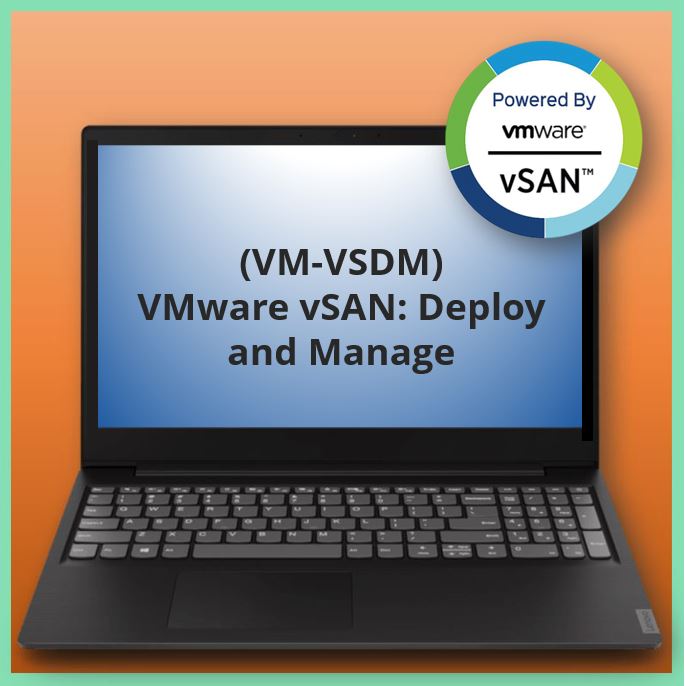Aangeboden leervormen

VMware vSAN: Deploy and Manage (VM-VSDM)
In this course, you focus on deploying and managing a software-defined storage solution with VMware vSAN™ 6.7. You learn how vSAN functions as an important component in the VMware software-defined data center. You gain practical experience with vSAN concepts through the completion of hands-on lab exercises.
Product Alignment
• ESXi 6.7
• vCenter Server 6.7
• vSAN 6.7
Course Objectives
By the end of the course, you should be able to meet the following objectives:
• Describe the vSAN architecture
• Identify vSAN features and use cases
• Configure vSAN networking components
• Configure a vSAN cluster
• Deploy virtual machines on a vSAN datastore
• Configure virtual machine storage policies
• Perform ongoing vSAN management tasks
• Configure vSAN encryption
• Control vSAN resynchronization tasks
• Create and manage nested fault domains
• Use the vSAN health service to monitor health and performance
• Configure a stretched cluster and observe failover scenarios
• Describe vSAN interoperability with VMware vSphere® features and other products
• Plan and design a vSAN cluster

Voor wie
Storage and virtual infrastructure administrators who want to use software-defined storage with vSAN
Programma
Course Introduction
• Introductions and course logistics
• Course objectives
• Describe the software-defined data center
Introduction to vSAN
• Describe basic vSAN architecture and components
• Describe the differences between file, block, and object storage
• Explain the advantages of object-based storage
• Detail the configuration of a vSAN cluster
• Install and validate the initial vSAN installation and configuration
vSAN Configuration
• Apply vSAN design considerations
• Detail the expansion of a vSAN cluster
• Configure vSAN disk groups manually
• Identify physical network configuration requirements
• Describe the configuration of vSAN networking
• Test and validate the vSAN configuration and functionality
• Describe the vSAN architecture and components
• Describe the differences between the vSAN hybrid and all-flash architectures
• Describe the advantages of all-flash architecture
• Describe the space-efficiency features of vSAN
• Describe the different vSAN assessment tools
• Explain vSAN License Details
vSAN Policies and Virtual Machines
• Explain how storage policies work with vSAN
• Define and create a virtual machine storage policy
• Apply and modify virtual machine storage policies
• Change virtual machine storage policies dynamically
• Identify virtual machine storage policy compliance status
Managing and Operating vSAN
• Explain how to configure encryption in the vSAN cluster
• Explain the management of hardware storage devices
• Identify alarms for vSAN events
• Describe and configure fault domains
• Describe the configuration of the vSAN iSCSI service, iSCSI targets, and LUNS
Stretched Clusters and Two-Node Clusters
• Describe the architecture for stretched clusters and two-node clusters
• Create a stretched cluster
• Describe how stretched cluster storage policies affect vSAN objects
• Create and apply a vSAN stretched cluster policy to meet specific needs
• Discuss the behavior of a stretched cluster when various types of failures occur
Monitoring and Troubleshooting vSAN
• Discuss hardware failure scenarios
• Describe the process of resynchronization
• Explain the possible reasons for resynchronization
• Describe the use of vSphere Client to detect issues
• Explain the use of the health service to monitor vSAN health
• Explain the use of the performance service to monitor vSAN performance.
• Monitor and test the vSAN environment
• Describe vSAN architecture components and the PNOMA OSI model.
Voorkennis
This course requires meeting one of the following prerequisites:
• Storage administration experience on block or file storage devices
• Understanding of concepts presented in the VMware vSphere 6.7: Install, Configure, Manage (VICM) course
Experience working at the command line is helpful.
The course material presumes that a student can perform the following tasks with no assistance or guidance before enrolling in this course:
• Use VMware vSphere® Client
• Create and manage VMware vCenter Server® objects, such as data centers, clusters, hosts, and virtual machines
• Create and modify a standard switch
• Create and modify a distributed switch
• Connect a VMware ESXi™ host to NAS, iSCSI, or Fibre Channel storage
• Create a VMware vSphere® VMFS datastore
• Use a wizard or a template to create a virtual machine
• Migrate a virtual machine with VMware vSphere® vMotion®
• Migrate a virtual machine with VMware vSphere® Storage vMotion®
If you cannot complete all of these tasks, VMware recommends that you complete the VMware vSphere 6.7: Install, Configure, Manage (VICM) course before enrolling in VMware vSAN: Deploy and Manage.
Duur training
Klassikaal: 3 dagen







